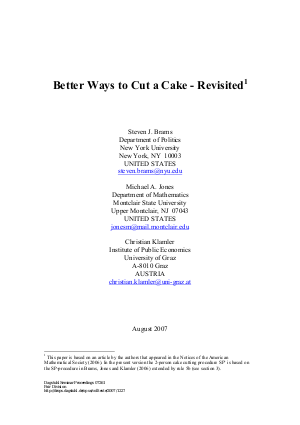Better Ways to Cut a Cake - Revisited
Authors Steven J. Brams, Michael A. Jones, Christian Klamler
-
Part of:
Volume:
Dagstuhl Seminar Proceedings, Volume 7261
Part of: Series: Dagstuhl Seminar Proceedings (DagSemProc) - License:
 Creative Commons Attribution 4.0 International license
Creative Commons Attribution 4.0 International license
- Publication Date: 2007-11-26
File

PDF
DagSemProc.07261.5.pdf
- Filesize: 212 kB
- 24 pages
Document Identifiers
Subject Classification
Keywords
- Fair division
- cake-cutting
- envy-freeness
- strategy-proofness
Metrics
- Access Statistics
-
Total Accesses (updated on a weekly basis)
0Document
0Metadata
Abstract
Procedures to divide a cake among n people with n-1 cuts (the minimum number) are analyzed and compared. For 2 persons, cut-and-choose, while envy-free and efficient, limits the cutter to exactly 50% if he or she is ignorant of the chooser's preferences, whereas the chooser can generally obtain more. By comparison, a new 2-person surplus procedure (SP'), which induces the players to be truthful in order to maximize their minimum allocations, leads to a proportionally equitable division of the surplus - the part that remains after each player receives 50% - by giving each person a certain proportion of the surplus as he or she values it. For n geq 3 persons, a new equitable procedure (EP) yields a maximally equitable division of a cake. This division gives all players the highest common value that they can achieve and induces truthfulness, but it may not be envy-free. The applicability of SP' and EP to the fair division of a heterogeneous, divisible good, like land, is briefly discussed.
Cite As Get BibTex
Steven J. Brams, Michael A. Jones, and Christian Klamler. Better Ways to Cut a Cake - Revisited. In Fair Division. Dagstuhl Seminar Proceedings, Volume 7261, pp. 1-24, Schloss Dagstuhl – Leibniz-Zentrum für Informatik (2007)
https://doi.org/10.4230/DagSemProc.07261.5
BibTex
@InProceedings{brams_et_al:DagSemProc.07261.5,
author = {Brams, Steven J. and Jones, Michael A. and Klamler, Christian},
title = {{Better Ways to Cut a Cake - Revisited}},
booktitle = {Fair Division},
pages = {1--24},
series = {Dagstuhl Seminar Proceedings (DagSemProc)},
ISSN = {1862-4405},
year = {2007},
volume = {7261},
editor = {Steven Brams and Kirk Pruhs and Gerhard Woeginger},
publisher = {Schloss Dagstuhl -- Leibniz-Zentrum f{\"u}r Informatik},
address = {Dagstuhl, Germany},
URL = {https://drops.dagstuhl.de/entities/document/10.4230/DagSemProc.07261.5},
URN = {urn:nbn:de:0030-drops-12278},
doi = {10.4230/DagSemProc.07261.5},
annote = {Keywords: Fair division, cake-cutting, envy-freeness, strategy-proofness}
}
